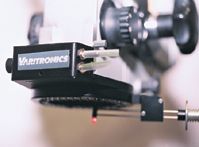Article
Better fixation can minimize induced astigmatism with CK
Philadelphia—The astigmatism induced by conductive keratoplasty (CK) can be minimized by obtaining better centration of the corneal template mark around the pupil.

A new instrument helps achieve this goal, according to Herbert J. Nevyas, MD.
"Monocular placement of the corneal treatment ring around the patient's iris using a fixation light that is movable to the center of the surgeon's monocular field is the key to eliminating the induction of astigmatism in CK that is the result of decentration," Dr. Nevyas stated. He explained that binocular fixation with a binocular microscope that is used by surgeons who perform CK creates two different simultaneous lines of sight for the placement of the treatment ring. However, both lines of sight are wrong, because there is parallax between the surface of the cornea and the iris of 3 or 4 mm, which provides surgeons with two choices: right eye and left eye both at an angle that is not straight. This applies to both CK and laser thermokeratoplasty.

"Perfect centration is necessary to reduce the induction of astigmatism and, particularly with CK, symmetric spot placement is vital to the success of the procedure. Monocular surgeon fixation is essential to obtain the appropriate centration," he emphasized.
It is important to note that when CK is performed, the power effect of the spot that is applied grows as it gets closer to the center of the cornea. The growth, he explained, is relatively exponential, not linear. The effect of this is that when the entire pattern of spots is moved to the side of the cornea, the spots closer to the center of the cornea add a great deal more astigmatism with the added power. This is in contrast to the more distant spot that is 180° opposite, the effect of which is diminished by being farther from the center of the cornea.
An advantage of CK, Dr. Nevyas noted, is that the procedure is forgiving.
"Surgeons can take the necessary time to center the marker ring precisely around the pupil. If the centration is not perfect, the surgeon can postpone the case, wait and re-mark, or compensate by adjusting the placement of the thermal spots," he said.
Movable fixation light The movable fixation light monocularly centered is the most important factor that allows the surgeon to see along the center of the cornea that should be marked. Dr. Nevyas uses an operative keratometer that he developed for use when performing astigmatic keratotomy (AK). The keratometer has a movable fixation light to move the patient's eye in order to make the AK incision more convenient to place.
The instrument has been modified for use during CK. Dr. Nevyas first minimized the footprint of the fixation light to allow the surgeon to continue to visualize the pupil despite the light being in the center of the surgeon's monocular field. There is also a port in the top of the fixation light so that the surgeon can see the fixation light, which makes the centration easier.
"When using the instrument, the patient fixates on a blinking light that is positioned in the center of the surgeon's field of view of one eye, so that the parallax is eliminated and the marker can then be centered precisely around the patient's pupil," Dr. Nevyas said.
He enumerated the steps that are essential to obtaining fixation.
"When actually placing the CK spots in the cornea," he noted, "binocularity is not a problem. Binocularity gives us stereopsis. Because there is no problem with parallax, the binocular microscope is used to perform CK," he said.
Newsletter
Don’t miss out—get Ophthalmology Times updates on the latest clinical advancements and expert interviews, straight to your inbox.




